Understanding Event Management Applications
What exactly does an
event management application manage? Less-sophisticated apps may focus
on one or two operations, such as event registration or facilities
booking. The more full-featured apps include management of everything
from pre-event marketing to post-event analysis.
Let’s take a look at what you can expect.
Event Planning and Workflow Management
A successful event
starts well in advance of its opening date. There are tons of details
involved in an event of any size, and managing all those tasks takes
quite a bit of computing horsepower—just the thing cloud computing can
help you out with. Most event management applications include robust
task planning modules, similar to what you’d find in higher-end task
management applications or lower-end project management apps.
What you want is the
ability not just to track individual tasks in a to-do list fashion, but
also benefit from sophisticated workflow management. That is, you need
to know which tasks need to be completed before later tasks can be
started; you need to know who’s doing what, and be alerted to any tasks
that are unstaffed or understaffed. In other words, you need the
planning and workflow management functionality to continue into the
event itself, so that you can manage your staff in an efficient and
effective manner.
Event Marketing
Unless you let people
know about your event, you could be disappointed with the final
attendance. To that end, many event management applications include
modules to help you market your event.
For example, many
apps offer web-based email marketing, which lets you promote your event
via targeted email messages. Other apps help you create your own event
website (on their cloud computers), which also helps to promote your
event.
Event Calendar
Another
part of your event marketing mix is an event calendar—an online
calendar that displays all the happenings within your overall event.
This proves particularly useful if you’re hosting a conference or trade
show made of lots of individual panels, sessions, or meetings. You can
post each individual event on the main event calendar, easily accessed
by any attendee or potential attendee with a web browser.
Facilities Scheduling
Unless you’re running a
one-room meeting, chances are your event involves multiple rooms and
maybe event multiple locations. If so, you need to be able to schedule
different rooms for different components of your event; when a
participant or group asks for a room, you need to be able to see what’s
available and when.
To that end, most
event management apps include a facilities scheduling module. Ideally,
this module ties into the event host’s systems, giving you complete
power over room or hall scheduling.
Advance Registration
Most larger events
require or encourage advance registration of participants. To that end,
most event management apps include a web-based registration module,
where attendees can sign up (and, in most cases, pay) for the event.
Attendee information is entered into a web form, and that data is then
stored on the application provider’s cloud servers. You then access
attendee data from your own computer, wherever you may be.
Some of the more
sophisticated advance registration modules provide additional
functionality. For example, you might want to collect demographic or
other information from attendees, and then use that information to help
plan specific programs during the event. Or a registration module might
tie into a hotel reservations module, to automatically reserve hotel
rooms for those who need them.
The registration module is
the backbone of the entire event management program. Make sure it does
everything you need it to do, and does so in a way that you find usable.
Payment Processing
Collecting
payment for your advance and onsite registrants is a key part of the
event management experience. You want the event management software to
tie payment processing into the registration process, letting you accept
payment via credit card, PayPal, or whatever other payment methods you
accept.
Travel Management
If you’re running a real
“hands-on” event, you might want to consider offering travel services
to select attendees. This may be as simple as arranging ground transfer
services (taxis, buses, and so on) between your local airport and the
event hotel, or as advanced as linking into an online travel site or
airline reservations system to provide flight reservations. Although not
all event management applications offer this type of functionality, it
is available with some apps if you need it.
Housing Management
More common is a
housing management module that helps match event attendees with
available rooms at your event hotel. Many attendees prefer to have the
event host handle their hotel reservations, so that you serve as kind of
a “one-stop shop” for all your attendees needs. The best event
management apps link directly from advance registration and payment into
the hotel’s reservation system—and then let you confirm rooms and such
at the event site.
Onsite Registration
Your attendees sign up
(and probably pay) for your event in advance. But when they arrive on
opening day, you need to sign them in, print out badges, provide a
welcoming packet, and so forth. All of these tasks are managed by the
event management application’s onsite registration module. Ideal onsite
registration ties into the advance registration and, optionally, the
housing management modules of the application. And, because it’s all web
based, you can manage all onsite activities via a notebook PC at the
event site, accessing your main database in the cloud.
Contact Management
Here’s a service
that many event managers offer attendees. Using the master database of
event guests, you can provide contact management services to help
attendees get in touch with one another. At the very least, your event
management application should let you print out (or host online) a
master directory of attendees, which can then be provided as part of the
welcoming packet of materials.
Budget Management
Running an event is
an expensive and complex undertaking; your overall budget includes
hundreds of individual expense items. To that end, your event management
application should include a robust accounting or budget management
module, to track both your expenses and your income.
Post-Event Reporting and Analysis
When the event is
(finally!) over, your job isn’t quite done yet. Not only do you have to
balance the books, you also need to look back on the entire event and
determine how successful it was. That’s why most event management
applications include some form of post-event reporting and analysis.
Some apps even let you send and process attendee surveys, which can
provide valuable feedback from those who were there. Look for a
reporting module that lets you see at a glance how you performed to plan
in a number of areas, not all of them financial. (For example, how many
hotel rooms were blocked out in advance versus how many rooms were
actually used?)
Exploring Event Management Applications
Now that you know what to
look for in an event management application, let’s look at the most
popular of these web-based apps. Whereas most perform similar functions,
some stand out from the pack in terms of what they do—or don’t—offer.
123 Signup
Taking these event management applications in alphanumeric order, the first out of the gate is 123 Signup (www.123signup.com).
The company offers four different applications: Event Manager,
Association Manager, Training Manager, and Member Directory. Of these,
the one in which we’re interested is the aptly named Event Manager.
Note
123Signup claims to be one
of the largest event management applications, having processed more
than 1,500 events, registered nearly a half million attendees, and
handled more than a million individual transactions.
123
Event Manager is scalable, so it can be used for both smaller (employee
meetings, stockholder meetings, alumni meetings, and so forth) and
larger (trade shows, fundraisers, conferences, and so on) events.
The application
handles a combination of front-office and back-office tasks.
Front-office tasks include defining and marketing events, automatically
generating informational web pages and registration forms, and marketing
your event via targeted email messages. Back-office tasks include event
registration, badge printing, payment collection, and database
management. The program even provides real-time reports on
registrations, attendance, collections, and other key factors.
Figure 1
shows a typical initial registration page. Potential attendees see
information about the event, including a link to a map of the event
hotel and the ability to add the event to their Microsoft Outlook
calendar. To begin the registration process, an attendee need only click
the Register icon; attendees are then prompted for their name and
contact info, as well as payment method.
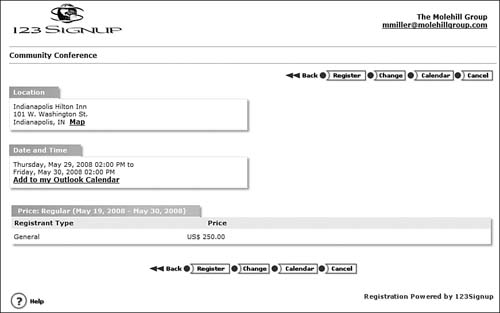
Acteva
Acteva (www.acteva.com) offers online event registration and payments. Using Acteva’s web-based solutions, you can handle event registration, ticketing,
and payment handling (via any major credit card) directly from your own
website. You can then sort and manage all event registration data
online.
You start by creating
what Acteva calls an Active Page for your event; this is simply a web
page with built-in payment handling and data processing. (You create
your Active Page by filling in a few web forms—it’s quite easy.) After
you’ve published your event page, you then use Acteva’s EventMail
service to send out notification of your event to potential attendees.
Interested parties then visit your Active Page to register and pay for
the event. Acteva processes and confirms event registration and sends an
email confirmation to the participant. You can then use Acteva’s online
event management tools to generate will call lists, meal preference
lists, name tags, badges, and the like.
Conference.com
Conference.com (www.conference.com)
offers one of the most full-featured web-based event management
applications available today. By using Conference.com’s cloud servers,
even small events can utilize the company’s powerful event management
tools, designed to serve the needs of the largest events. Your data (and
the behind-the-scenes application modules) are hosted by
Conference.com’s secure servers, accessible from any Internet-enabled
location.
The company offers a
wealth of features for events big and small. You get wizard-based event
setup, real-time credit authorization, customizable web pages and forms,
onsite processing, and the like. When an event participant submits his
registration via your custom-designed web form, the application
automatically updates the database on Conference.com’s web servers, so
your information is always up-to-date.
Conference.com’s Event Manager Systems application is actually a suite of interlocking modules, as shown in the diagram in Figure 2. These modules include the following:
Appointment Manager,
an online meeting scheduling application. This module enables attendees
to self-schedule one-to-one sessions with other participants at your
event, within time slots that you predefine.
Credit Card Manager, offering real-time credit card authorization integrated into the registration process.
Email Manager, an email broadcasting utility that dynamically pulls recipient names from your registration data.
Export Manager, an export/import utility that lets you copy the data from one event to another event in your database.
Hotel Manager,
a professional room block management tool tightly integrated with the
company’s Registration Manager module. The system manages everything
from small single property blocks to citywide room inventories. Each
room type is defined with its own price, description, and starting
inventory; as a room is sold, the nightly inventory for that room type
is automatically adjusted.
Lead Track Manager uses bar code technology to verify session attendance and provide lead tracking services to exhibitors.
Profile Manager
links member, employee, customer, and prospect databases with your
conference registration processing, enabling attendees to authenticate
themselves through a login web page.
Registration Manager
is the core module of Conference.com’s Event Manager systems. This
module contains the accounting engine, report engine, a graphical report
library, and other functions that integrate directly with other modules
in the suite.
Survey Manager
enables you to create professional-looking online surveys at any point
in the event process. You can solicit pre- or post-event attendee
surveys; Survey Manager lets you email invitations with hyperlinks that
take the user to the correct survey form.
Travel Manager, which helps you manage ground transfer services between multiple airports and event hotels.
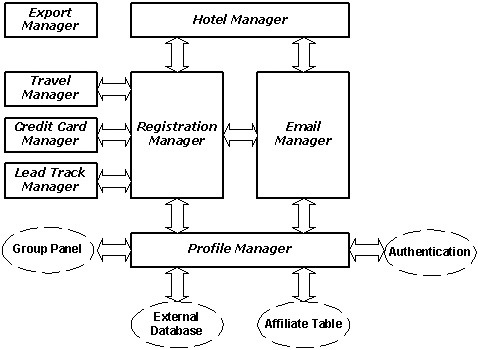
Together,
this suite of modules creates a full-featured event management
application that should handle the needs of any sized event.
Cvent
Competing directly with Conference.com is Cvent (www.cvent.com), with its Event Management system. Like Conference.com, Cvent’s Event Management system is a suite of interrelated tools, including the following:
Event Registration, including online event registration, branded event websites, data collection, and generation of name badges and mailing labels
Email Marketing, with automated invitations, “save-the-date” reminders, confirmations, and post-event “thank you” messages
Secure Online Payment Processing, which lets you accept payment by all major credit cards—and offer “early-bird” discounts to motivated participants
Housing and Travel Management,
which provides a one-step process for attendees to sign up, pay, get a
hotel room, reserve an airline flight, and receive all relevant
follow-up communications
Contact Management, which creates a professional directory or address book from all entered participant information
Budget Management, which helps you build, track, and analyze budgets for your events
Custom Event Websites, which helps you launch a custom website for your event—complete with onsite promotion of event sponsors
Event Workflow Management, which helps you manage the entire event planning process from start to finish, complete with to-do list emails for event staff
Event Calendar, a web-based calendar that displays all events open for registration
On-Site Functionality,
which enables you to check in attendees as they arrive onsite, provide
self-registration kiosks, print session-attendee lists, create bar-coded
name badges, and process live credit card payments
Event Reporting, which lets you access event data in real-time via a library of standard and custom reports
Cvent’s functionality may be even more than that offered by Conference.com; you should definitely compare the two if you need to manage a large or complex event.
Event Wax
Event Wax (www.eventwax.com)
isn’t quite as full featured as other event management solutions . In fact, it really isn’t designed to handle
large-scale events such as trade shows and conferences. Instead, Event
Wax is for smaller-scale in-house events, such as company meetings,
parties, open houses, and the like.
That said, Event Wax
performs many of the same functions as the more full-featured programs.
You can schedule multiple events, send out email invitations, create
event web pages, enable attendee self-registration, and the like. You
can even sell tickets for your event, as shown in Figure 3, with different types of tickets at different prices.
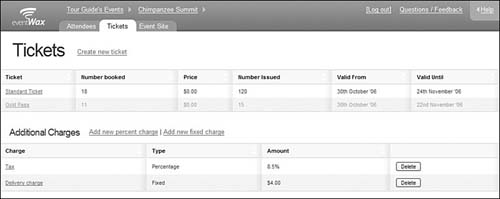
eventsbot
Our next event management application is eventsbot (www.eventsbot.com),
which offers online event registration and ticketing. You can use
eventsbot to plan and manage your event, sell tickets in your choice of
currency, collect credit card payments, and even promote your event with
major search engines and event directories.
Creating a new event with
eventsbot is as easy as filling in a few web forms. This creates a
cloud-based website for your event, like the one shown in Figure 4. You can then activate ticket selling for the event, which takes place on this web page. After that, eventsbot handles ticket and attendee management for your event.
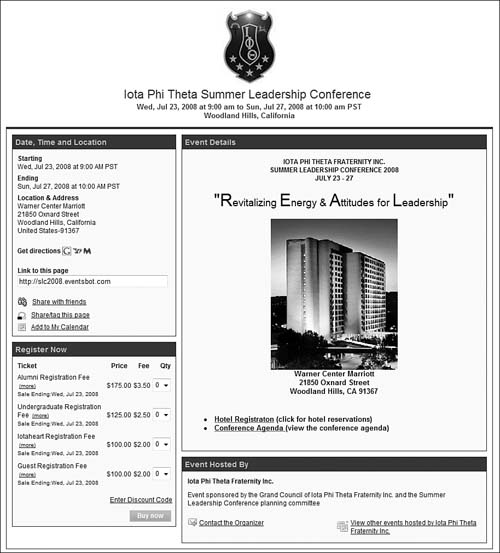
RegOnline
Like eventsbot, RegOnline (www.regonline.com)
offers online event registration and payment. You use RegOnline to
create a website for your event, create web-based registration forms,
accept credit card payments, send automatic email reminders and
confirmations, print name badges and room signs, and generate all manner
of custom reports. The application also handles the reservations of
individual hotel rooms and room blocks.
Figure 5
shows how easy it is to get started with RegOnline. This event builder
page walks you through the event creation process via a series of web
forms. Fill in the relevant information to generate a web page and other
functions for your event.
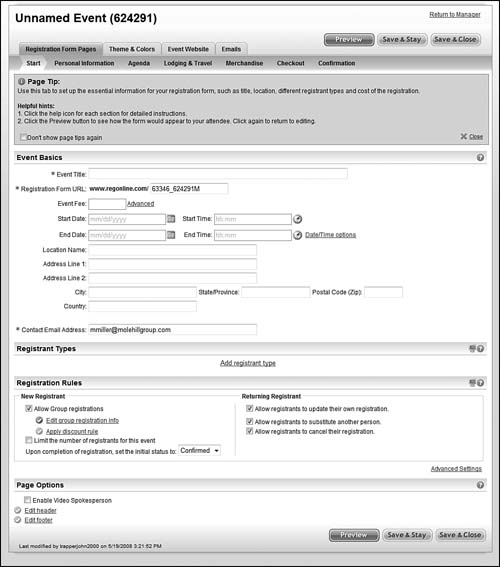
Setdot
Setdot (www.setdot.com)
isn’t really for large corporate events; it’s more of a stylish
web-based way to schedule and manage smaller personal events and
activities. Setdot lets use choose from various preset themes for your
event web page. It even displays maps and directions to events. And,
although it’s mainly for smaller events, it does manage guest responses
and messages.
Tendenci
Here’s another unique approach to event management. Tendenci (www.tendenci.com) combines a web-based calendar application with online registration and payment. You create an event calendar, like the one in Figure 6,
which you embed in your own website. When an interested party clicks an
event link, he’s taken to a dedicated page for that event, where he can
see more information and register online. You can then manage the
attendee data, print name tags, and the like.
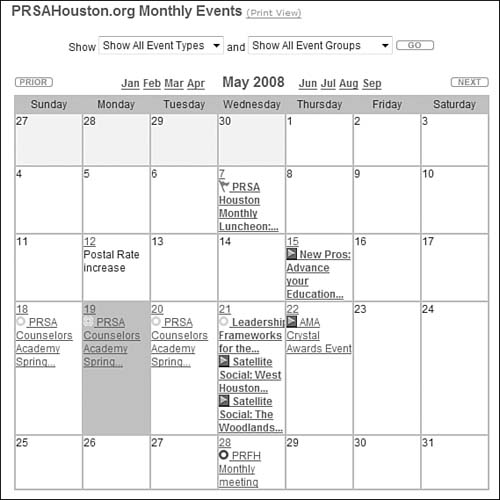
|
Event management is a
process-intensive endeavor. There’s so much involved in managing event
the smallest event, it really benefits from the power of cloud
computing.
Here’s the thing: Even a
small event has beaucoup number of individual pieces and parts, all of
which can benefit from behind-the-scenes computing horsepower. It’s
seldom cost-effective, however, to purchase the hardware and software to
manage these events; you might use the same software applications to
manage a 25-person seminar as you do to manage a 1,000-person trade
show, even though the 25-person seminar brings in less revenue.
Unfortunately,
although both events have the same management needs, the smaller event
probably can’t afford the traditional type of event management software
that the larger event has the budget for.
This is where cloud
computing comes to the rescue. By tapping into the same server cloud as
the larger event, the smaller event can now afford the same level of
event management. The same applications are used, just with less server
horsepower.
Cloud computing also
lets you take event management from the office to the event site. The
attendee database isn’t landlocked on your company’s computers; it’s
located on the web, where it’s accessible from any web browser. So fire
up a series of computer terminals in the event registration room, or
just take your notebook PC with you. Everything you or your attendees
entered prior to the event is there for your onsite access—which is
great not just for onsite registration, but also for solving those
niggling problems that always tend to spring up the day of the event! |